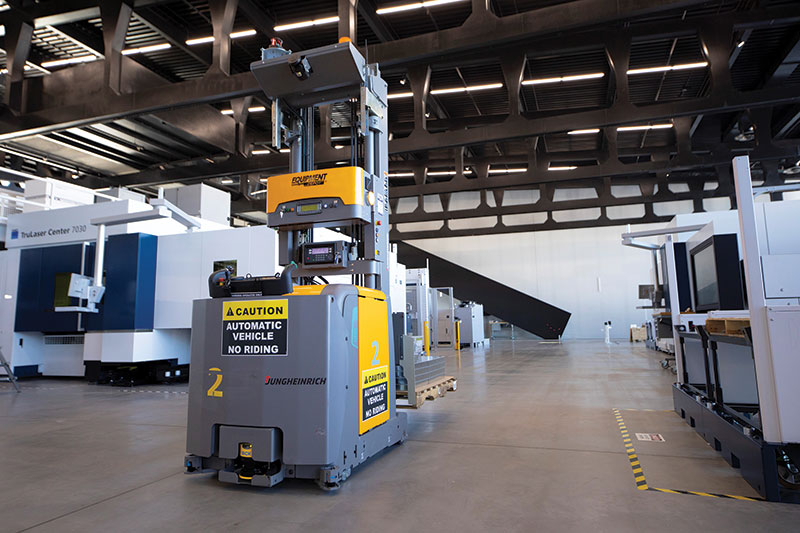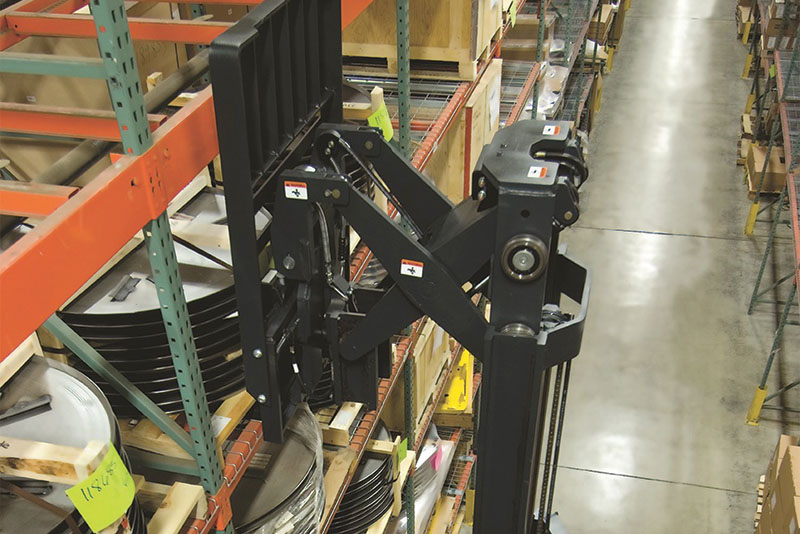Smart Factory gets efficiency boost from AGV lift trucks
The AGV deployment at TRUMPF Group’s Smart Factory near Chicago allows the company’s workforce to focus on value-added manufacturing processes, while the AGVs take care of the supporting material moves, fully synchronized with the manufacturing process.
In the suburbs of Chicago, TRUMPF Group operates a state-of-the-art Smart Factory that not only showcases the company’s own machine tool, laser cutting and digital manufacturing technologies to customers, but it also manufactures some parts at the site.
The 24,000-square-foot facility uses the latest in TRUMPF’s technology at its manufacturing work centers, and additionally, it has deployed autonomous lift trucks to automate the movement of materials between and to the factory’s high-tech work centers.
Before deploying the system, the site relied on manually operated, sit-down lift trucks and pallet jacks to move materials. The problem was that this could eat up valuable time for skilled production operators who otherwise could be fully focused on manufacturing parts at the Smart Factory’s high-tech work centers. Moving these materials could consume two to three hours per shift per operator, in some cases.
In keeping with its belief in efficiency and keeping human efforts focused on directly value-added production steps, the company looked at automating materials handling by implementing automatic guided vehicle (AGV) lift trucks.
The AGV lift trucks selected (Jungheinrich AGVs from Mitsubishi Logisnext Americas) integrate with TRUMPF’s production management or “fab” software, automatically moving the correct materials to each work center when needed in a reliable, safe manner.
According to Robert Leahy, customer and central services manager, use of the AGVs fits with the company’s philosophy of identifying areas of waste and replacing it “with an automatic process” where that makes sense.
Inside the factory, sheet metal is cut with high-powered lasers, bent and shaped by robotic arms and loaded onto pallets by conveyor belts. Previous to the AGV deployment in 2018, those pallets were then moved by human operators using traditional forklifts, but this ate up valuable time the operators spend at their work centers making products.
“They’re at the machines forming parts, assembling parts, shipping parts… actually what the customer is paying you for. And that’s only possible using the AGVs,” Leahy says.
The AGVs integrate with the company’s fab software used to manage the factory’s production processes. With this integration, as soon as materials are ready to move from one work center to another, or new materials need to enter the system, the software communicates with the AGV system to trigger needed moves. As Leahy explains, this integration allows for a smooth, autonomous flow of materials without delays or unnecessary buildup of work-in-process materials.
“We can see what parts are moving from one station to the next, which means improved throughput,” Leahy says. “There’s no overburden going on in our facility. We have the right parts at the right machine to produce and meet the customer’s order on time.”
The AGV system at the Smart Factory is considered non-invasive to the layout, meaning it does not require special tape or guidance infrastructure on the floor to permit precise navigation. The Jungheinrich models used include the EKS215a, which is capable of lifting 3,300 pounds and running two full shifts on one charge. These units do make use of small reflectors on select points in the facility to support fully autonomous navigation, with fleet management software from Jungheinrich also being part of the solution. Jungheinrich’s software manages battery charging, use levels, and IT integration to the company’s software.
The big win with the AGV system, agrees Megan Baumgartner, system control engineering supervisor, comes back to the fact that the AGVs allow production operators to stay focused on core tasks and interacting with their production machinery, rather than functioning as part-time materials handlers. That benefits the Smart Factory’s workforce, who can focus on production tasks and system knowledge.
“[The operators are] now able to stay at their work centers, and I’m seeing an increase in their productivity because they’re not leaving their work center to go find a part,” says Baumgartner. “The automatic guided vehicles are here to support the workforce. We’re able to take our employee and increase their skill set.”













